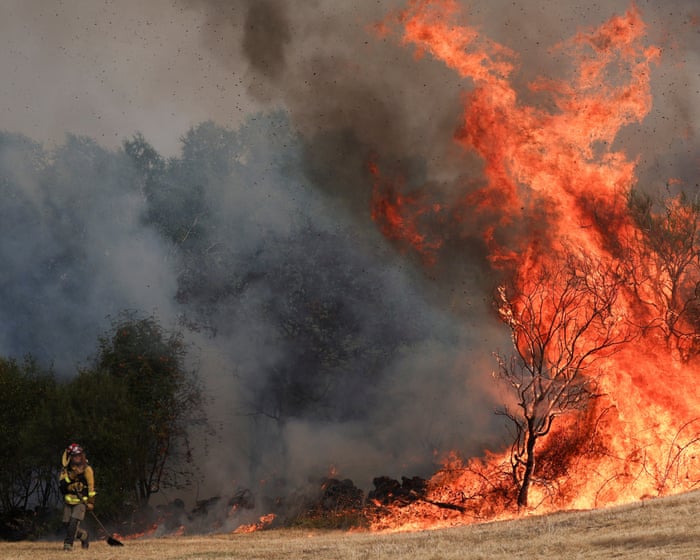Spain’s environment minister has called the recent deadly wildfires, fueled by extreme heat, a “clear warning” about the climate crisis. The fires have killed two people, destroyed thousands of hectares of land, and displaced thousands across the country.
As firefighters in Spain, Greece, and other Mediterranean nations continued battling dozens of blazes on Wednesday, Environment Minister Sara Aagesen said the 14 fires still burning across seven Spanish regions highlight the country’s particular vulnerability to global warming. While some fires may have been started deliberately, she stressed that the devastating blazes underscore the urgent need for better preparation and prevention.
“The fires are one consequence of climate change, which is why we must do everything possible to prevent them,” Aagesen told Cadena Ser radio. “Spain is especially vulnerable to climate change. We have resources now, but with scientific evidence pointing to worsening impacts, we need to strengthen and professionalize those resources.”
Her comments followed record-breaking temperatures in southern Spain, where some areas exceeded 45°C (113°F). The national weather service reported unprecedented heat between August 1 and 20.
A 35-year-old volunteer firefighter died Tuesday in Castilla y León, where fires have forced over 8,000 evacuations and left seven people hospitalized with severe burns, four in critical condition. Hours earlier, a 50-year-old man died after suffering 98% burns while trying to rescue horses from a stable near Madrid.
By Wednesday, the Madrid fire was under control, but blazes in Galicia had consumed 11,500 hectares (30,000 acres). Prime Minister Pedro Sánchez thanked emergency crews working “tirelessly” to contain the fires, warning the situation remains serious.
In Portugal, over 2,100 firefighters and 20 aircraft battled five major fires, including one in Trancoso that has burned since Saturday. Strong winds reignited flames overnight, threatening nearby villages where locals joined firefighting efforts under heavy smoke.
Greece, which requested EU aerial support, deployed nearly 5,000 firefighters against blazes fueled by gale-force winds. Emergency crews fought “a titanic battle” in the Peloponnese, Epirus, and on the islands of Zakynthos, Kefalonia, and Chios, where thousands of residents and tourists were evacuated. Wildfires have destroyed homes, farms, and factories, while 15 firefighters and two volunteers suffered burns, heatstroke, and other injuries.
Late Wednesday, a man was seen herding goats to safety near Patras as flames approached.A massive fire broke out on the Greek island of Chios, destroying land that was still recovering from June’s devastating wildfires. As flames reached the coastline, coastguard teams quickly evacuated people by boat to safety.
Meanwhile, near the western city of Patras, Greek Red Cross volunteers fought to control wildfires advancing toward villages. By Wednesday afternoon, news footage showed flames on the outskirts of Patras, Greece’s third-largest city. Local authorities opened an emergency shelter to provide food, water, and refuge for affected residents.
Officials evacuated a children’s hospital and a retirement home as a precaution, while local media reported that a 17th-century monastery outside the city had its roof engulfed in flames.
In Preveza, where fires started on Tuesday, 17 nearby settlements lost power and water.
“This will be another difficult day, with an extreme fire risk across most of the country,” fire service spokesperson Vassilis Vathrakoyiannis said in a televised statement. “By order of the fire chief, all emergency services, including civil protection units, are on high alert.”
At dawn, 33 water-dropping planes and helicopters were deployed to battle the flames. Meteorologists predict temperatures above 35°C (95°F), with further increases expected later this week—peak summer for Greece. The country’s prolonged drought and record heat have left vegetation dangerously dry, creating ideal conditions for wildfires.
In related incidents, a forestry worker died while fighting a wildfire in southern Turkey after a fire truck accident that injured four others. Turkey has faced severe wildfires since late June, with 18 fatalities so far, including 10 rescue volunteers and forestry workers killed in July.
In southern Albania, a wildfire triggered explosions when it ignited buried World War II-era artillery shells. Officials confirmed an 80-year-old man died in a separate fire south of the capital, Tirana.
(The Associated Press and Agence France-Presse contributed to this report.)
FAQS
### **FAQs About Spain’s Wildfires and the Climate Crisis**
#### **Basic Questions**
**1. Why are Spain’s wildfires a warning about climate change?**
Spain’s wildfires are becoming more frequent and intense due to hotter, drier conditions caused by climate change. A government minister highlighted them as a sign of worsening climate impacts.
**2. What causes wildfires in Spain?**
Common causes include extreme heat, drought, human activities (like unattended campfires), and sometimes natural factors like lightning.
**3. How does climate change make wildfires worse?**
Higher temperatures dry out vegetation, turning it into fuel for fires. Longer heatwaves and less rainfall create ideal conditions for wildfires to spread quickly.
**4. Are wildfires in Spain getting worse?**
Yes, wildfires are burning larger areas and happening more often due to rising temperatures and changing weather patterns.
#### **Intermediate Questions**
**5. What role does the government play in preventing wildfires?**
Governments enforce fire bans, manage forests to reduce fire risks, and fund firefighting teams. They also work on climate policies to reduce long-term risks.
**6. How do wildfires affect Spain’s environment and people?**
They destroy forests, wildlife habitats, and farmland, harm air quality, and sometimes force evacuations, putting lives at risk.
**7. Can better forest management reduce wildfires?**
Yes, controlled burns, clearing dry brush, and planting fire-resistant trees can help prevent large, uncontrollable fires.
**8. What’s the link between heatwaves and wildfires in Spain?**
Heatwaves dry out soil and plants, making them more likely to catch fire. Spain has seen record-breaking heat, increasing fire risks.
#### **Advanced Questions**
**9. How do Spain’s wildfires compare to other countries’?**
Like California and Australia, Spain faces more extreme fires due to climate change, but its Mediterranean climate makes it especially vulnerable.
**10. What long-term climate solutions could reduce wildfires?**
Cutting greenhouse gas emissions, switching to renewable energy, and restoring ecosystems can help slow climate change and reduce fire risks.
**11. Are some regions in Spain more at risk than others?**
Yes, dry, forested areas like Andalusia, Catalonia, and Valencia are high-risk, but fires can occur anywhere during heatwaves.
**12. How can




